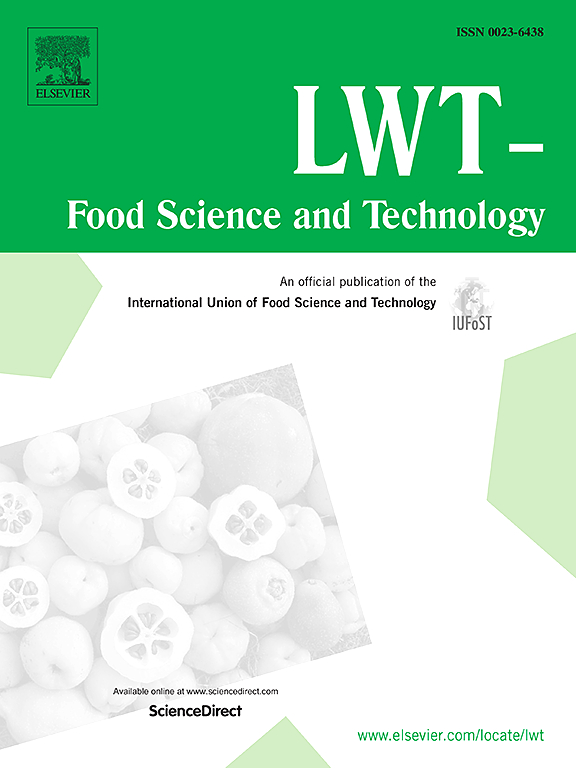Inactivation of foodborne pathogens on fruit juice with different solid contents by using pilot-scale 915 MHz microwave heating system
IF 6
1区 农林科学
Q1 FOOD SCIENCE & TECHNOLOGY
引用次数: 0
Abstract
Fruit juices are often distributed in the form of concentrate for the sake of quality conservation and cost-reduction during distribution. The objective of this study is to investigate the effect of solid content on heating rate, dielectric properties, and foodborne pathogen inactivation in fruit juices when subjected to 915 MHz microwave heating. 50 mL of fruit juice with different solid contents were exposed to 915 MHz microwave at 3.0 kW for up to 60 s. Solid content was found to be an important factor for heating rate. The fastest heating rate was observed when concentrates were diluted by 50% (36 Brix apple and 30 orange juice). Though dielectric constant decreased along with increase in solid contents, different trends were observed for the dielectric loss factor. Especially, the fruit juices with higher magnitudes of the dielectric loss factor presented faster heating rate. Inactivation of the pathogens inoculated in the fruit juices was investigated by using E. coli O157:H7 and L. monocytogenes. In case of apple juice, 915 MHz microwave heating was most effective for 72 as 20 s operation resulted in over 5-log reduction for both pathogens. However, in orange juice, 30 was found to be most effective for 915 MHz microwave heating. In the inactivation mechanism analysis, cell membrane damage was observed when cells were exposed to higher solid contents due to low water activity. 915 MHz microwave heating did not include significant quality changes in terms color and total phenolic contents, except for 60 Brix of orange juice. The obtained results highlight the potential application of 915 MHz microwave heating for fruit juice processing
利用中试规模的 915 MHz 微波加热系统灭活不同固体含量果汁中的食源性病原体
为了保证质量和降低销售成本,果汁通常以浓缩果汁的形式销售。本研究旨在探讨果汁在 915 兆赫微波加热时,固体含量对加热速率、介电性质和食源性病原体灭活的影响。将 50 毫升不同固体含量的果汁暴露在 3.0 千瓦的 915 兆赫微波中长达 60 秒。当浓缩果汁稀释 50%(36 ° Brix 苹果汁和 30 ° Brix 橙汁)时,加热速度最快。虽然介电常数随着固体含量的增加而降低,但介电损耗因子却呈现出不同的趋势。尤其是介电损耗因子较高的果汁,加热速度更快。通过使用大肠杆菌 O157:H7 和单核细胞增生性酵母菌,研究了果汁中接种的病原体的灭活情况。在苹果汁中,915 MHz 微波加热对 72 °Brix 的果汁最有效,20 秒的加热时间可使两种病原体的数量减少 5 个菌落。然而,在橙汁中,915 MHz 微波加热对 30 °Brix 最有效。在灭活机理分析中,当细胞暴露于较高的固体含量时,由于水活性较低,细胞膜会受到破坏。除白利糖度为 60 ° 的橙汁外,915 MHz 微波加热在色泽和总酚含量方面没有引起明显的质量变化。这些结果突出了 915 MHz 微波加热在果汁加工中的潜在应用。
本文章由计算机程序翻译,如有差异,请以英文原文为准。
求助全文
约1分钟内获得全文
求助全文
来源期刊

LWT - Food Science and Technology
工程技术-食品科技
CiteScore
11.80
自引率
6.70%
发文量
1724
审稿时长
65 days
期刊介绍:
LWT - Food Science and Technology is an international journal that publishes innovative papers in the fields of food chemistry, biochemistry, microbiology, technology and nutrition. The work described should be innovative either in the approach or in the methods used. The significance of the results either for the science community or for the food industry must also be specified. Contributions written in English are welcomed in the form of review articles, short reviews, research papers, and research notes. Papers featuring animal trials and cell cultures are outside the scope of the journal and will not be considered for publication.
 求助内容:
求助内容: 应助结果提醒方式:
应助结果提醒方式:


